Search results for "Wenping Qiu"
Getting the juicy details
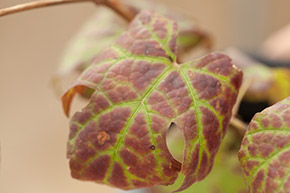
According to Qiu, grapes host the largest number of viruses of any plant because it’s a perennial woody plant.
When a Missouri vineyard manager contacted Dr. Wenping Qiu in 2004 to express concerns about a disease plaguing his vineyard, Qiu speculated the decline was caused by a virus. Unable to find the link with known viruses after two years of testing, Qiu and his research team began utilizing a relatively new technology called RNA (Ribonucleic Acids) sequencing to decipher the sequences of small RNA fragments to piece together the viral genome.
It was in 2009 that Qiu, research professor in the William H. Darr School of Agriculture at Missouri State University, discovered the first DNA virus ever reported in grapevines, named the Grapevine vein clearing virus (GVCV). Though he was hopeful of a new discovery, he remained somewhat doubtful.
“We only found a small piece (of DNA),” said Qiu. “So my colleagues and I decided we have to find an entire genome of this virus before we can present the discovery to the public.” In 2011, after mapping out all 7,753 base pairs of DNA in the genome, they published their results.
Drawing a diagram, Qiu explained the complicated process of piecing together these fragments, designing primers from these fragments, sequencing them and searching for similar sequences in the gene bank. Using polymerase chain reaction (PCR) technology, Qiu and others in his lab amplified the fragments out and repeated the process. They designed more primers, piece by piece, until the fragments overlapped and they knew the viral genome was circular.
“We sequenced thousands of those small fragments, and then we compared our fragment sequences with sequences in the gene bank. And then we found, ‘oh, this is new!’”
During the past 10 years, Qiu has been the principal investigator on numerous grants from the state and federal Department of Agriculture, leading to approximately $2 million in grant funding for his research. And all of that research stems from this interest in grapes.
But why grapes? According to Qiu, grapes host the largest number of viruses of any plant because it’s a perennial woody plant. Therefore, they are a great model for the progression and prevention of diseases. But DNA and RNA viruses multiply differently, so much research is still being conducted on how this virus multiplies and spreads over time.
“When a plant is infected by a virus, the plant tries to defend and protect itself against all types of viruses. It starts to cut the virus into small pieces. So in the infected plant cells, you can find the relics – or small pieces – of the virus genome.”
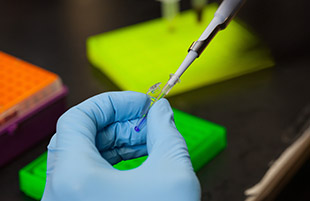 In recent years, RNA sequencing has been grabbing attention in the scientific community – it can be used to discover new viruses in other plants, animals and even humans. Discoveries of new viruses allow scientists and doctors to learn about how the viruses cause diseases and spread.
In recent years, RNA sequencing has been grabbing attention in the scientific community – it can be used to discover new viruses in other plants, animals and even humans. Discoveries of new viruses allow scientists and doctors to learn about how the viruses cause diseases and spread.
Through study of the GVCV in an isolated environment – in the Springfield laboratory as well as on Missouri State’s Mountain Grove campus, which is home to the Fruit Experiment Station, the Center for Grapevine Biotechnology and Mountain Grove Cellars – Qiu hopes to learn all he can about how to prevent its spread as it is quite detrimental to grape production in a vineyard.
Students dig deep into Grapevine vein clearing virus
Plant science students at Missouri State have unparalleled opportunities under Qiu’s supervision, who has been honored with an endowed professorship in agriculture by President Clif Smart and his wife Gail. The Grapevine vein clearing virus (GVCV) is the focus of two intense studies: one study is trying to discern which grape varieties are resistant to this virus; another study being conducted by graduate students Michael Kovens, LeAnn Hubbert, Shae Honesty and Ru Dai focuses on the genome of a new strain of the virus recently discovered in a wild grapevine.
“It’s important to find which grape varieties are prone to the virus and which ones aren’t because any varieties found to be resistant or tolerant to GVCV can potentially be used in breeding to prevent infection in those varieties that are more susceptible,” said Kovens.
Kovens is passionate about this work because he has seen the decline in quality grape production, noting symptoms such as leaf rolling, translucent veins, and shortened internodes, which eventually kill the vines.
“This study is crucial as the quality and quantity of the wine able to be produced is negatively affected by the virus,” he added.
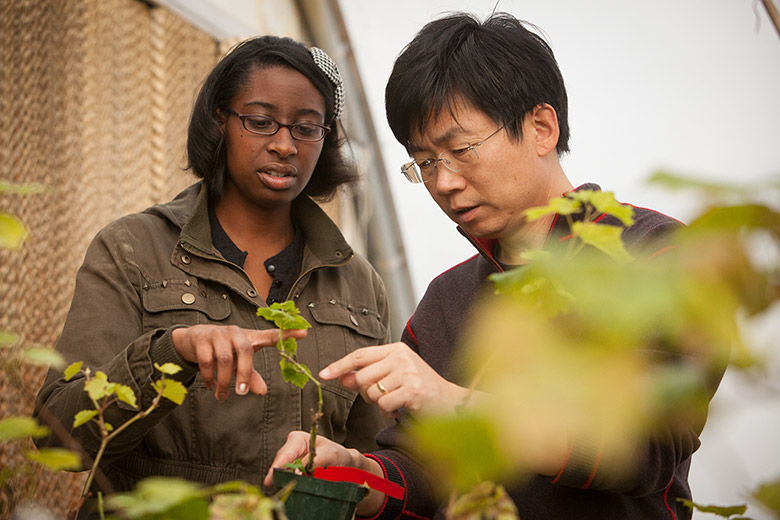
A study being conducted by graduate students Michael Kovens, LeAnn Hubbert, Shae Honesty and Ru Dai focuses on the genome of a new strain of the virus recently discovered in a wild grapevine.
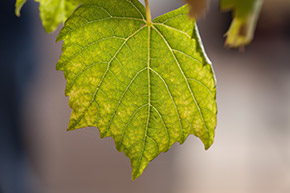 Walking through wild grapevines
Walking through wild grapevines
Missouri is known for its natural beauty and a wide variety of outdoor activities to enjoy. While out on a hike, you will likely stumble upon a bramble of wild grapevines.
“Wild grapes are everywhere in the Ozarks. Actually, in the 1870s, millions of cuttings of wild grapes were collected from Missouri and shipped to France to rescue their grape industry,” said Qiu.
While GVCV was first discovered in a cultivated, commercial vineyard, Qiu’s natural curiosity got him speculating about whether the virus might also be found in wild grapevines and what that would mean about the virus’ origin.
“We thought, maybe it is possible that this virus jumps from the wild grape species to the cultivated grapevines in the vineyard,” noted Qiu.
So he and his students collected samples of wild grapes and tested the virus on a particular wild grape species – Vitis rupestris. In one vine, GVCV was detected, which indicates it does exist in the wild. From there, Qiu and his research team sequenced the entire genome of the new strain and are now comparing its sequence to the one discovered in the cultivated grape varieties.
Hubert, another of Qiu’s students, accompanies him to Swan Creek to collect samples from Vitis rupestris to understand how it is transferred from one vine to another. One theory is that insects transfer the virus among wild vines.
A recent trip to Swan Creek found several vines showing symptoms of GVCV, so the team clips small vines, bags them with creek water and transports them to the laboratory. There they pot the plants, watch them grow and confirm if it has GVCV. Qiu noted, though, that the symptoms on the wild vines are consistent with those in the greenhouse, meaning they are most likely from the same virus.
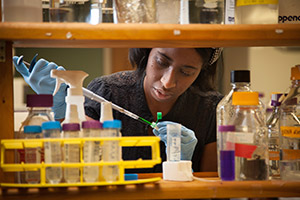 Mapping the genome of Norton grapevine
Mapping the genome of Norton grapevine
Norton – the state grape of Missouri – makes a dry, deep red, full bodied table wine. It’s a hardy grape that survives despite temperature fluctuations and is naturally resistant to many diseases. Several years ago, Qiu and his colleagues at the State Fruit Experiment Station studied Norton’s resistance to one debilitating mold for grapes – powdery mildew. From there, they have expanded their research to begin mapping the genome of the Norton grapevine.
“When a fungal spore lands on the surface (of a Norton), it begins to germinate,” he explained. “But when it penetrates a plant cell wall, the Norton responds very quickly so that those cells that are attacked by fungal spores commit suicide – they just die.”
This hypersensitive response makes the Norton prepared for battle, ready to defend against outside agents.
“Indeed we found that the Norton naturally had high levels of these defense genes,” he said. “It’s a very fascinating phenomenon in grapes.”
Keeping an eye on grape research worldwide is important to Qiu. When he began mapping the Norton grapevine genome, he and the University came to a collaborative agreement with the French National Institute for Agriculture Research – an institution that was analyzing sequences of the Norton genome as well.
“We’ve collected the raw sequences of the Norton genome, and now we’re putting the puzzle together.” It’s a puzzle with millions of pieces, so mapping the entire genome of the Norton grapevine will take years, Qiu estimates. In comparison, the total length of the human genome is over 3 billion base pairs, which took the global scientific community 13 years to complete.
Growing and selling healthy grapes
Worldwide more than 5,000 grape varieties exist; however, in Missouri, about a dozen of popular varieties thrive. At the Mountain Grove campus, several vineyards boast grapes like Norton, Traminette, Chardonel, Chambourcin, Cayuga White, Vidal Blanc and Vignoles. These grapes are harvested each August to begin the winemaking process for Missouri State’s Mountain Grove Cellars to bottle and sell, but the vines have a greater purpose. Qiu is busy testing these grape varieties for presence of viruses – and virus-tested vines are being sold to vineyards with assurance of good health.
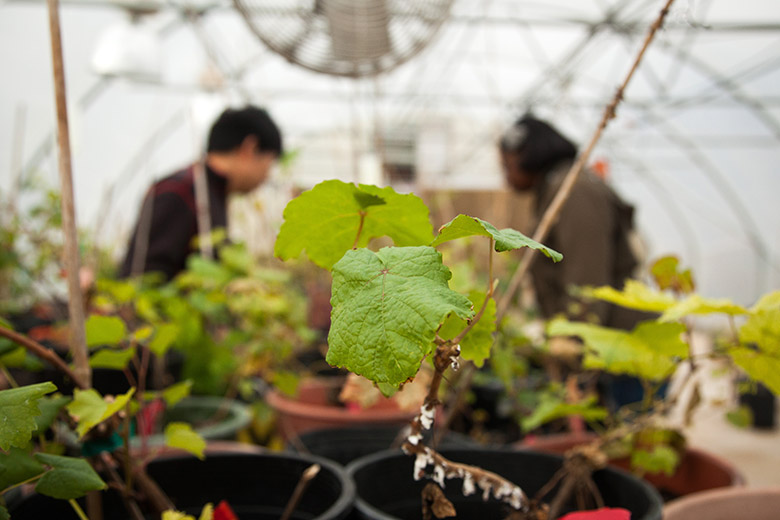
“We all want to learn more about new viruses. By studying this virus, we can develop some strategies for preventing this virus from spreading.” – Dr. Wenping Qiu
“Those seven grape varieties were tested and found to be free of 16 grape viruses. Those 16 grape viruses are serious viruses that affect grape production,” he said. “So when we sell these to grape growers or nurseries, at least they know those mother plants can be propagated free of these 16 grape viruses.”
A current project in Qiu’s laboratory is testing the resistance of a grapevine to viruses. How do they do it? First they test the grapevine to make sure it is healthy and free of any virus. Then, they graft the viruses onto the vines to see if these vines are able to support the viruses.
“This is something we are doing right now,” said Qiu. They hope to see that these vines are resistant, and then investigate the genetic basis for this resistance. “We all want to learn more about new viruses. By studying this virus, we can develop some strategies for preventing this virus from spreading.”
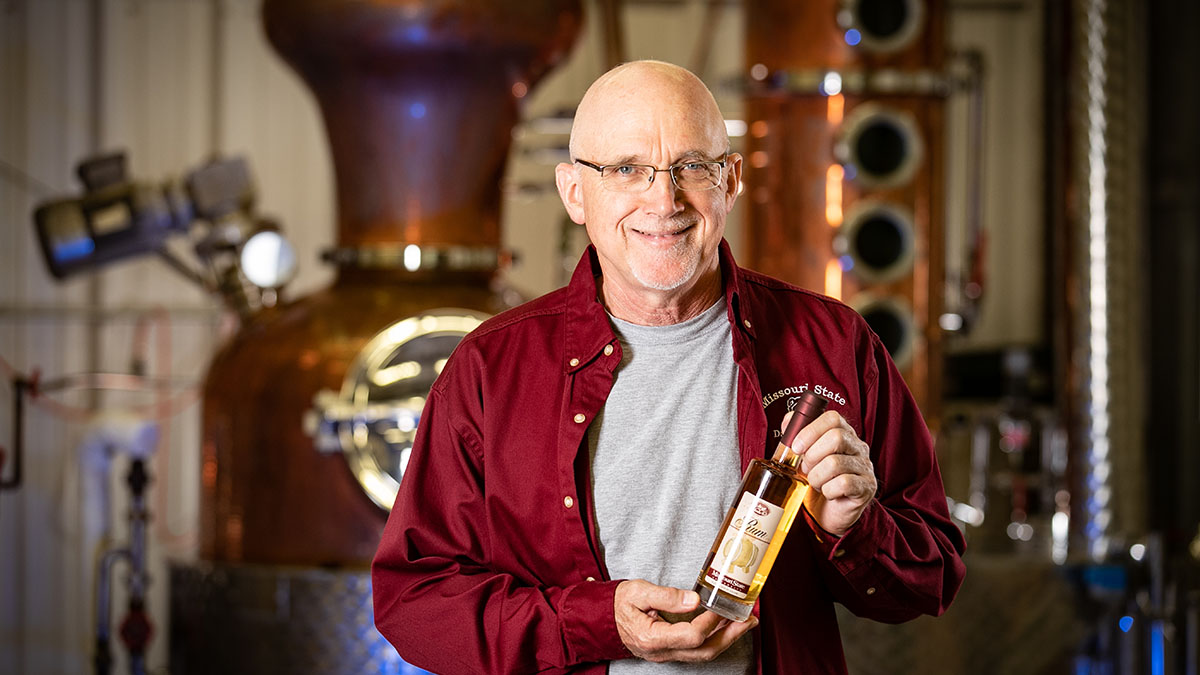

Keeping grape populations healthy
Here, researchers like Dr. Wenping Qiu, director, and Dr. Chin-Feng Hwang, associate professor at the William H. Darr School of Agriculture, explore grape genetics. They want to increase the profitability of the grape and wine industry, ensure its stability and improve human health with their genetic findings.
One of the primary grapes studied at the center is Missouri’s official state grape, the Norton — which is grown at the State Fruit Experiment Station on the Mountain Grove campus. The researchers study disease resistance in order to keep the plants healthy.
“Norton, (scientific name Vitis aestivalis), the official grape of the state of Missouri, is grown in many U.S. regions where production of V. vinifera (the European grape used for most wine-making worldwide, e.g., pinot noir) requires extensive pesticide use for fungal diseases,” Hwang said. “It has been reported that Norton is hardy and resistant to several fungal pathogens including powdery mildew, downy mildew, Botrytis bunch rot and black rot.”
With some of the most recent findings, the research team hopes to expedite efforts to breed the Norton grape with the ultimate goal of improving viticultural performance and enological quality of new grape varieties well-adapted to Missouri conditions.



